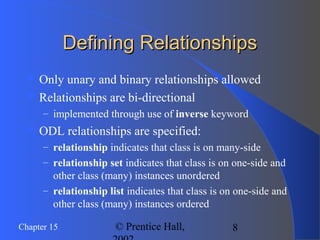The Database Environment Chapter 15
- 1. 1 © Prentice Hall, 2002 Chapter 15:Chapter 15: Object-Oriented DatabaseObject-Oriented Database DevelopmentDevelopment Modern Database Management 6th Edition Jeffrey A. Hoffer, Mary B. Prescott, Fred R. McFadden
- 2. 2Chapter 15 © Prentice Hall, Object Definition LanguageObject Definition Language (ODL)(ODL) Corresponds to SQL’s DDL (Data Definition Language) Specify the logical schema for an object- oriented database Based on the specifications of Object Database Management Group (ODMG)
- 3. 3Chapter 15 © Prentice Hall, Defining a ClassDefining a Class classclass – keyword for defining classes attributeattribute – keyword for attributes operationsoperations – return type, name, parameters in parentheses relationshiprelationship – keyword for establishing relationship
- 4. 4Chapter 15 © Prentice Hall, Defining an AttributeDefining an Attribute Value can be either: – Object identifier OR Literal Types of literals – Atomic – a constant that cannot be decomposed into components – Collection – multiple literals or object types – Structure – a fixed number of named elements, each of which could be a literal or object type Attribute ranges – Allowable values for an attribute – enum – for enumerating the allowable values
- 5. 5Chapter 15 © Prentice Hall, Kinds of CollectionsKinds of Collections Set – unordered collection without duplicates Bag – unordered collection that may contain duplicates List – ordered collection, all the same type Array – dynamically sized ordered collection, locatable by position Dictionary – unordered sequence of key-value pairs without duplicates
- 6. 6Chapter 15 © Prentice Hall, Defining StructuresDefining Structures Structure = user-defined type with components structstruct keyword Example: struct Address {struct Address { String street_addressString street_address String city;String city; String state;String state; String zip;String zip; };};
- 7. 7Chapter 15 © Prentice Hall, Defining OperationsDefining Operations Return type Name Parentheses following the name Arguments within the parentheses
- 8. 8Chapter 15 © Prentice Hall, Defining RelationshipsDefining Relationships Only unary and binary relationships allowed Relationships are bi-directional – implemented through use of inverse keyword ODL relationships are specified: – relationship indicates that class is on many-side – relationship set indicates that class is on one-side and other class (many) instances unordered – relationship list indicates that class is on one-side and other class (many) instances ordered
- 9. 9Chapter 15 © Prentice Hall, Figure 15-1 –UML class diagram for a university database The following slides illustrate the ODL implementation of this UML diagram
- 10. 10Chapter 15 © Prentice Hall, Figure 15-2 –ODL Schema for university database
- 11. 11Chapter 15 © Prentice Hall, Figure 15-2 –ODL Schema for university database class keyword begins the class definition.Class components enclosed between { and }
- 12. 12Chapter 15 © Prentice Hall, Figure 15-2 – ODL Schema for university database attribute has a data type and a name specify allowable values using enum
- 13. 13Chapter 15 © Prentice Hall, Figure 15-2 –ODL Schema for university database extent = the set of all instances of the class
- 14. 14Chapter 15 © Prentice Hall, Figure 15-2 –ODL Schema for university database Operation definition: return type, name, and argument list. Arguments include data types and names
- 15. 15Chapter 15 © Prentice Hall, Figure 15-2 –ODL Schema for university database relationship sets indicate 1:N relationship to an unordered collection of instances of the other class inverse establishes the bidirectionality of the relationship
- 16. 16Chapter 15 © Prentice Hall, Figure 15-2 –ODL Schema for university database relationship list indicates 1:N relationship to an ordered collection of instances of the other class
- 17. 17Chapter 15 © Prentice Hall, Figure 15-2 –ODL Schema for university database relationship indicates N:1 relationship to an instance of the other class
- 18. 18Chapter 15 © Prentice Hall, Figure 15-3 – UML class diagram for an employee project database (a) Many-to-many relationship with an association class Note: In order to capture special features of assignment, this should be converted into two 1:N relationships
- 19. 19Chapter 15 © Prentice Hall, Figure 15-3 – UML class diagram for an employee project database (b) Many-to many relationship broken into two one-to-many relationships class Employee { (extent employees key emp_id) …………. attribute set (string) skills_required; }; Note: key indicates indentifier (candidate key) Note: attribute set indicates a multivalued attribute
- 20. 20Chapter 15 © Prentice Hall, Figure 15-4 UML class diagram showing employee generalization class Employee extends Employee{ ( …………. …………. } Note: extends denotes subclassing
- 21. 21Chapter 15 © Prentice Hall, Figure 15-5 –UML class diagram showing student generalization abstract class Student extends Employee{ ( …………. abstract float calc_tuition(); } Note: abstract operation denotes no method (no implementation) of calc_tuition at the Student level Note: abstract class denotes non- instantiable (complete constraint)
- 22. 22Chapter 15 © Prentice Hall, Creating Object InstancesCreating Object Instances Specify a tag that will be the object identifier – MBA699 course (); Initializing attributes: – Cheryl student (name: “Cheryl Davis”, dateOfBirth:4/5/77); Initializing multivalued attributes: – Dan employee (emp_id: 3678, name: “Dan Bellon”, skills {“Database design”, “OO Modeling”}); Establishing links for relationship – Cheryl student (takes: {OOAD99F, Telecom99F, Java99F});
- 23. 23Chapter 15 © Prentice Hall, Querying Objects in the OODBQuerying Objects in the OODB Object Query Language (OQL) ODMG standard language Similar to SQL-92 Some differences: – Joins use class’s relationship name: Select x.enrollment from courseofferings x, x.belongs_to y where y.crse_course = “MBA 664” and x.section = 1; – Using a set in a query Select emp_id, name from employees where “Database Design” in skills;
- 24. 24Chapter 15 © Prentice Hall, Current ODBMS ProductsCurrent ODBMS Products Rising popularity due to: – CAD/CAM applications – Geographic information systems – Multimedia – Web-based applications – Increasingly complex data types Applications of ODBMS – Bill-of-material – Telecommunications navigation – Health care – Engineering design – Finance and trading
- 25. 25Chapter 15 © Prentice Hall, Table15-1 – ODBMS Products
























